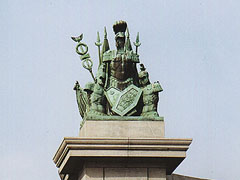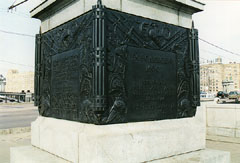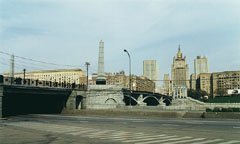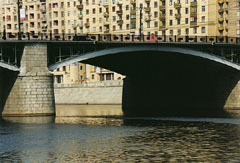|
BORODINO BRIDGE
| |

 Decorative pyramids of ancient military armors and banners, crowing the colonnade of the Doric Order." Decorative pyramids of ancient military armors and banners, crowing the colonnade of the Doric Order."
|

 Cast-iron boards with heroes' names of the Patriotic war of 1812. Cast-iron boards with heroes' names of the Patriotic war of 1812.
|

 View to the Borodino bridge from the side of the Kievsky station. View to the Borodino bridge from the side of the Kievsky station.
|

 One of the three arches of the Borodino bridge. View from the quay of the river Moscowa. One of the three arches of the Borodino bridge. View from the quay of the river Moscowa.
|
News about prince Kutuzov's decision to leave Moscow without fighting spread very quickly in troops but as recalled later Volkonsky «the general spirit of the army was not bad; everybody clearly understood that the defense of Moscow on the Vorobievy mountains — would lead to the full destruction of the army and that it was necessary to bring this great victim to the boon of Fatherland».
The troops that abandoned Moscow ought to move slowly in one large column through Dorogomilovsky gate and river Moscowa. Kutuzov was also among them. The transports started their moving only at 3 o'clock in the morning of September 2 to the Dorogomilovsky bridge and further along the streets of Moscow. After them moved irregulars, then infantry and artillery. The Cossacks brought up the rear of the army.
«The Army passed through Moscow in order and silence, — informed the «Diary of military operations» — a deep grief was written on soldiers faces and it seemed that each of them entertained in the heart a vengeance for insult, as though it was made personally to him».
The soldier's boots tapped evenly on the wooden corduroy on the entrance to the Dorogomilovsky bridge. Silently the water splashed to the rafts and ferries which served as piers to the wooden flooring. Thick boards bended and scratched under the weight of guns and ammunition wagons. And though that time the Dorogomilovsky bridge had the length of 186 meters and width only 8,5 meters, the troops passed without a bottle-neck, giving a way to the commanders and aide-de-camps, galloping through and by with the instructions. There was a moment when the old bridge broke down. For some time the troops crowded around it, but Kutuzov who was passing by has ordered , as usually quietly, about immediate repair of the bridge. And soon the troops prolonged their slow motion.
In XVI century on the place of the Dorogomilovsky bridge there was a ferry which linked Dorogomilovo with Moscow. Boatmen and ferrymen transported for small fare from one coast to another noblemen with servants or merchants with their goods, peasants living nearby and townspeople - artisans. In winter certainly an ice cover of the Moscowa - river became a bridge. In the beginning of the XVII century there was so-called "living" bridge - it's flooring lied directly on the water. Each year the motion to the capital increased from the Smolensky tract (road) so very soon a question of construction of the constant bridge was rised up. In 1787 — 1788 a new wooden bridge was built, which shared in quarter of century the honor to be the witness of leaving Moscow by troops and inhabitants in 1812.
In a sorrow silence the regiment by regiment, the company by company the Russian army passed through the Dorogomilovsky bridge. Artilleryman N. Mitraevsky recalled «I have not noticed any signs of despair on the soldiers faces but I watched gloomy and concentrated expression of revenge». And the vengeance has come...
In August 1837 Russia celebrated the 25th anniversary of the Borodino battle. Then the Dorogomilovsky bridge was renamed into the Borodino bridge.
In 1868 the Borodinsky wooden bridge was replaced by the iron bridge on two high piers with ice starlings. It's roadway length was 139 meters and width 15 meters and was overlapped by metal trusses. At the entrance you can see stone arches with decorative cupolas on it's corners. The bridge was built by the project of the engineer I.T. Shpeer.
The bridge existed as is till 1909, when it was reconstructed by the project of the architect R. P. Klein and engineer N. I. Oskolkov. The roadway was widen almost to 28 meters at the same length and number of piers.
The opening of the bridge was held in 1913. Klein transformed the Borodino bridge by thought-out architectural design into the peculiar monument of Russian soldiers who died on the Borodino field.
In 1938 the bridge was partially renovated. The second reconstruction took place in 1950 — 1952. The Borodino bridge was considerably expanded and elongated. Under its congresses there are arched passages which opened the way to the quay under the bridge. The initial architectural appearance of the bridge - monument was saved.
In 1970 the works over clearing and repairing of the granite lining of the bridge were made by the specialists of the trust Gorgidromost.
In the beginning of 1978 the executive Mossovet Committee approved the project of vast repair of the Borodino bridge which ought to replace the over arched elements of the bridge which were staggered by corrosion to the new metal constructions from special bridge steel. Other parts of the bridge have been also reconstructed. For this purpose the bridge was "opened", its paving was removed, and the flooring from gutter iron was replaced by the reinforced concrete. These complex activities were executed by specialists of the Glavmostingstron trust, which also participated in the last reconstruction of the Borodino bridge. For the first time after its construction the cast-iron ornament of colonnades was restored. Stone dressers refreshed the lining of bridge piers, colonnades and abutments by granite plates specially choosed to match by color and also made new a granite side. The works were completed by repairing of sidewalks and putting the new asphalt cover on the roadway of the Borodino bridge.
From Bolshaya Dorogomilovskaya street you can see grey granite obelisks at both sides of the bridge entrance. By form they reminded those old immovable mile-posts which were placed at the Moscow's entry from the side of the ancient Dorogomilovsky border post.
The colonnades of Doric order, disposed by semicircle can be seen from the part of the Smolenskaya square on each side of its entry. The general cornice ties together six columns and on it the cast iron decorative pyramids made from ancient military armors and banners. The riverside installations of the bridge are executed in the form of bastions. You can see medallions with the images of different military attributes placed on the cast-iron railing of parapet. The architect succeeded to attach the bridge - monument by solemn and triumphal character which underlined greatness of the Russian people victory in the Patriotic war of 1812.
The cast-iron boards with names of heroes were attached to the pedestals of well-shaped tetrahedral obelisks. On the four memorable boards of the obelisk's left side you can see the names of the outstanding commanders and military leaders:
«To commemorate the memory of a heroic feat of the Russian people and glorious Russian army which defended the independence of our Fatherland in the Patriotic war of 1812.
The outstanding military leaders of the Russian army — Michael Kutuzov, Peter Bagration, Michael Baclay de Tolli.
The outstanding commanders of the Russian army — K. Baggovut, N.Borozdin, D. Dochturov, A. Ermolov, P. Konovnitzin, I. Kulnev.
The outstanding commanders of the Russian army — A. Kutaisov, N. Lavrov, P. Ligatchev, M. Miloradovich, D. Neverovsky, A. Osterman-Tolstoi.
The outstanding commanders of the Russian army — M. Platov, N. Raevsky, K. Tol,A.A.Tuchkov, N.A.Tuchkov, F.Uvarov».
You can see the names of guerrillas who covered themselves by glory on the three boards of the right obelisk decorated by the relief of military armors:
«To commemorate the memory of a heroic feat of the Russian people and glorious Russian army which defended the independence of our Fatherland in the Patriotic war of 1812
The organizers and chiefs of army guerilla detachments — Denis Davidov, Ivan Dorojov, Alexander Seslavin, Alexander Figner.
The organizers and chiefs of people's guerilla detachments — Ivan Andreev, Gavriil Ankydinov, Boris Borisov, Emelian Vasiliev, Semen Emelianov, Stepan Eremenko, Ivan Ilin.
The organizers and chiefs of people's guerilla detachments — Vasilisa Kogina, Gerasim Kurin, Fedor Potapov, Nikifor Saveliev, Ivan Skobelev, Egor Stulov, Ermolay Tchetvertakov».
The inscription on the fourth board of this obelisk, shortly informed us about the history of the bridge:
«The Borodino bridge had been constructed in 1912 to commemorate the memory of the Patriotic war of 1812. It was reconstructed in 1952».
Names and surnames... All of them are connected forever, part and parcel of the year 1812. The granite obelisks of the Borodino bridge towered above in the memory of these remarkable people. And they have undoubtedly deserved the eternal memory and glory of the people because the life of each of them — is a feat. Lets look through the destiny of two heroes which names are casted on the obelisks - the destiny of a soldier and a general who struggled for the Fatherland in severe days of 1812.
Ermolay Tchetvertakov, native of the village Nefedovka of the Chernigovsky region, soldier of the Kievsky dragoon regiment, participant of napoleonic wars, started his service in 1804 and commanded the guerilla detachment in 1812.
In one of rear guard fight with the enemies at August 19, 1812 for the village Tsarevo-Zaimishe a horse under Tchetvertakov was fatally wounded. Unarmed he was taken as a prisoner. The fourth night when a group of prisoners have been stopped at night near Gjatsk, Ermolay escaped. In the village Zadkovo Tchetvertakov succeeded to collect a guerilla group from 50 persons, armed by self-made peaks, axes and pitchforks. Near the village Krasnoe which is in 27 kilometers from the Smolensky road the Tchetvertakov's detachment passed with honor the baptism of fire, having destroyed a subdivision of enemies cuirassiers. Having armed the guerillas by carabines and having transplanted his "soldiers" on the cavalry horses, Tchetvertakov accelerated their training. Soon an enemies provision transport was captured which have been guarded by infantry demi company, which was superior to the Tchetvertakov forces.
Some time has passed and the Tchetvertakov's detachment had more than 300 persons. This allowed the brave guerilla commander to work out a special tactics of the operations. In the nearby villages he kept small groups of guerrillas which were capable to beat off themselves raids of small-sized enemies groups. At the appearance of considerable enemy detachments these groups immediately informed the guerilla's headquarters, and in the meantime watched enemies movements. Besides this with the reconnaissance purposes Tchetvertakov dispatched mounted patrols up to tens kilometers to the regions Kolotzky monastery, Gjatsk, Medini, villages Nikolskoe and Michailovka. The guerrilla forces were significantly augmented, their skill of possessing sabre and gun had grown. They already ventured to attack the regular units of «Great Army». Once, having found out from the scouts about approaching of the enemies batallion with two cannons Tchetvertakov collected very quickly near the village Skygorevoy more then four thousand armed peasants from neighboring villages. By unexpected attack the guerrillas forced the enemy to retreat in haste and pursued it up to Gjatsk. In this fight the guerrillas trapped the large provision transport. In the fight near village Krigovo the guerrillas captured about 70 enemy soldiers. And in some days the guerrillas have beaten off the transport with property stolen in the village Tzvetkovo and have returned to the peasants - fodder, foodstuffs, clothes and other things.
The horse guerilla group of Tchetvertakov more than once made audacious raids on enemies transports and reinforcements which moved on the Smolensky road. Quick and decisive operations of Tchetvertakov kept from destroying the whole region in Gjatsky district.
When the Napoleon invasion rolled back to Vyazma, Tchetvertakov returned in his regiment in November, 1812. For his feats and bravery this soldier - patriot and the talented organizer was named the corporal and was awarded by Georgevsky cross. In the ranks of the Kievsky dragoon regiment E.Tchetvertakov passed the liberation campaign of Russian troops in 1813 — 1814 and also took part in seizing of Paris.
For some time a brilliantly educated nobleman Alexander Osterman-Tolstoy struggled in ranks of the 1-st Western army togather with private Tchetvertakov. In 1812 he commanded the fourth infantry regiment.
When Osterman was a 20-year old officer he took part in the assault of Ismail. To the beginning of napoleonic wars he was already a real commander, tried and tested in battles, passed Suvorov's school.
In the Patriotic war of 1812 Osterman-Tolstoy's military talent was brightly showed. July, 13 in the battle under Ostrovno Osterman made an courageous offensive against superior enemy forces, and then with an improbable persistence withhold its main forces. When Osterman was reported about big losses and asked what to do he answered: «To stand and to die». The resistance and bravery of everybody loved commander have inspired the soldiers, and the enemy couldn't move forward. After the contusion in the Borodino battle, Alexander returned soon to his regiment and in August, 1813 made a feat of arms under Kulm, where he constrained twice superior forces of the enemy up to the approach of the main troops. Even having missed his hand, the hero has refused to abandon the battle field, indicating «to braves true road to the victory».
But the combats were ended and in 1815 Osterman dismissed. In two years his request has been satisfied.
He died in Switzerland on February 11, 1857 in the age of 87 years and was buried on the modest cemetery in the suburb of Geneva . And though the tomb of this outstanding soldier in the foreign country was not kept, his name alongside with other names of the heroes will be always remembered by grateful descendants.
|